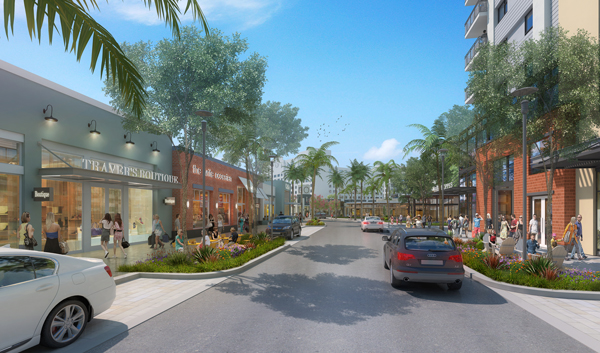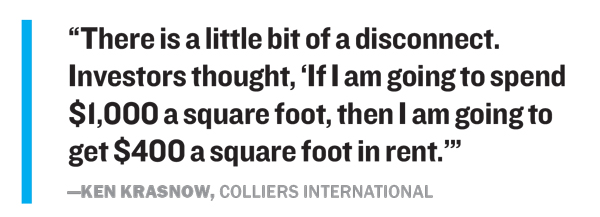Trending
Retail’s rent markup

As South Florida’s retail real estate sector continues to show strength — an anomaly as the rest of the country sees vacancy rates creep ever higher — some worry that landlords in the tri-county region’s hottest neighborhoods and high streets are just a bit too optimistic about the market.
While rents continued to rise in the third quarter, a recent JLL report said a decline in deals suggests rents in the Miami and Fort Lauderdale markets have peaked and will soon tumble. “Transaction volume has dried up and occupancy rates are beginning to retreat,” the report said. A slew of new retail-focused, mixed-use developments — as well as industrial warehouses being converted into retail — in neighborhoods like Wynwood and Allapattah have been slow in signing tenants, a JLL company spokesperson said in a statement. “The occupancy levels cited in the report are reflective of the vacancy in newer retail developments, so transactions have not kept up with added supply,” the statement read.
But continued low vacancy rates this year have emboldened landlords, and some of them are looking for rents that exceed current market norms.
“In segments where you have seen dramatic investment activity, like Lincoln Road, the Design District and Wynwood, there is a little bit of a disconnect,” said Ken Krasnow, executive managing director for Colliers International’s South Florida region. “Investors thought, ‘If I am going to spend $1,000 a square foot, then I am going to get $400 a square foot in rent.”
While the retail vacancy rate stood at 10 percent nationally in the third quarter, according to data from Reis, rates in Miami-Dade and Broward counties were at 3.6 percent, Colliers reported, and in Palm Beach, the rate was 4.4 percent. Meanwhile, rental rates in South Florida posted a 17 percent increase year over year, according to Colliers.
Despite healthy overall vacancy rates and rents trending upwards in South Florida, there are signs that should cause landlords to think twice about high rent expectations.
A closer examination of some submarkets revealed a downward slide. For instance, Lincoln Road’s vacancy rate climbed to 13 percent in the third quarter of 2017, up 4.5 percentage points from the same period last year. Yet at $305 per square foot, Lincoln Road has the highest average asking retail rent among the nine prime retail destinations in Miami-Dade, according to a Q3 2017 Miami retail report by Cushman & Wakefield.

Justin Berryman
Whether landlords are willing to lower their asking prices depends on their long-term strategy, Krasnow said. “Some can hold and wait,” he said. “It is really a function of how patient their capital is.”
Retailers looking at new space or whether to renew leases in the Lincoln Road area, the Design District and Wynwood are exercising more caution now that they are facing the prospect of paying $300 or more per square foot, Krasnow said. Some retailers now need smaller spaces because stores are carrying less inventory to put on shelves and keep in storage rooms. That has an impact on how much rent they are willing to pay, Krasnow added.
“When you throw in high pricing on top of how tenants plan to utilize the space, they will wait until they can figure out if paying more is worth it,” he said.
However, Justin Berryman, director of Franklin Street’s Miami office, said landlords seeking higher rents don’t think the South Florida market is going to cool off.
“They believe they can get more because rent prices keep climbing,” Berryman said. “[But] there is a limited pool of higher-end tenants that can pay those higher rates. Landlords think there is a greater pool.”
He said landlords are willing to ease up on their asking prices if they have confidence a prospective tenant has the financial wherewithal to occupy a space in the long term, as well as the ability to drive traffic to other tenants. “Those are significant factors in negotiations,” Berryman said.
He usually advises landlords to consider lowering their expectations, because even if a tenant agrees to their asking price, it may not be sustainable. “You can get them to pay it, but will they still be there in two or three years paying a high rent? If the answer is no, then the landlord is back to square one, and they may not be able to get the next tenant to pay that high rate,” he said.
Still, there are pockets in South Beach, Brickell and downtown Fort Lauderdale where Berryman said landlords can demand the high rates because foot traffic remains strong.
And he said new shopping destinations like Brickell City Centre can ask for higher rents than the going market rates in the Brickell neighborhood, which hit $61.23 a square foot, according to the Colliers Q3 2017 report. “It’s a place that keeps people there, and consumer traffic is around the clock,” Berryman said. “Those are some reasons why Brickell City Centre can demand higher rents compared to off-street shopping centers.”
 Some brokers and landlords said there are still other factors that will allow them to get higher rents even as retailers across the country are looking at ways to cut real estate costs. John Dowd, vice president of retail development for Encore Capital Management, said South Florida’s growing population, tourism and a strong U.S. dollar mean tenants can expect to generate higher revenues and can afford to pay a higher rent.
Some brokers and landlords said there are still other factors that will allow them to get higher rents even as retailers across the country are looking at ways to cut real estate costs. John Dowd, vice president of retail development for Encore Capital Management, said South Florida’s growing population, tourism and a strong U.S. dollar mean tenants can expect to generate higher revenues and can afford to pay a higher rent.
Of course, it is not uncommon for landlords and brokers to see the market differently. “The disconnect has always been there,” Dowd said. “There is always that push and pull until you both get to a middle ground.”
Dowd pointed to the way his firm has approached potential retail tenants for its $350 million mixed-use project at the site of the former Plantation Mall as an example of how to make the case for higher rents.
Encore did its homework on Plantation, Dowd said, noting the development site is located in a high-traffic area, making it easier to convince tenants that the company’s rental rate, while it may be steep, is worth the price.
“We put together a solid pro forma that has a basis in logic and fact,” he said. “We understood what the market could bear.”
Encore Capital is building 700 rental apartments, 250,000 square feet of office space and 200,000 square feet of retail at the 32-acre complex at 321 North University Drive. The company also renovated an existing 160,000-square-foot office building and a 263-room Sheraton Hotel on the site. The first phase of the retail portion is close to 65 percent leased, Dowd said.
“I don’t see a lot of pushback in the rents or pro forma we are asking for,” he said. “It’s nice when you can dial things up a little bit.”
Sabrina Stimming, senior vice president and head of retail leasing for CREC, said she has only encountered isolated cases involving clients that expected higher rents than the current market rates. “[The isolated cases] are primarily driven by owners of recently purchased assets,” Stimming said.
New owners have to justify their underwriting, so they often push for rates that the brokerage community does not think are in line with current market conditions. “When we come across these cases, we educate the client about the market and what the competition is asking for,” she said. “There is a disconnect between what they want and what they can get.”
The landlords of new assets will hold out for tenants willing to pay a higher rent until they realize getting an income stream is more important. Depending on the owner, the sit-and-wait period can last between three and six months, she said.
“Then they might settle for less than the rate that they hoped to achieve,” Stimming said. “But we are there to execute the client’s’ vision. And if they are expecting to see certain rents above current market conditions, we are going to push rents up.”
She said pushing rents up has not been that difficult in South Florida. “Landlords are in the driver’s seat,” she said. “There is a lot of competition for a limited amount of space, and deal volume is high. So we are seeing escalating rates.”
She said CREC is pushing rents up for retail clients in Doral, Kendall and Pinecrest. “We are getting deals done at rates we haven’t seen before,” Stimming said.
Brokers can also drive up rent prices because high occupancy rates and a minimal amount of new retail space in South Florida are driving up demand for vacant storefronts, Stimming said.
“If you are getting pushback from a tenant, one of their competitors is almost certainly willing to step in,” she said. “It may seem there is a disconnect between what the market sets and what owners want, but the lack of retail space and the deal velocity continue to push prices up.”
But with approximately 2.3 million more square feet of retail space currently under construction in Miami-Dade, according to the Colliers Q3 report, landlords may not be able to call the shots for much longer.




